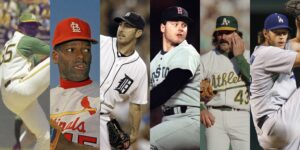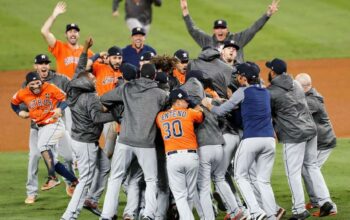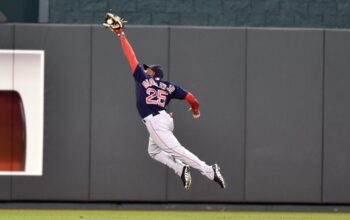
Welcome to another edition of Saber rattling. Who’s got two thumbs and is still writing for Baseball Almanac? This guy!
Before going on, I need to acknowledge that I haven’t been able to get this column published as often as I would like. You see, I’m the entire operation. I also have a day job and family to tend to. In addition, I’ve spent the bulk of the playoffs refining my soon-to-be-famous (insert laughter) baseball betting tool, which has been all-consuming. If you are willing to indulge that there simply aren’t enough hours in the day to accomplish all that I want, we’ll get along just dandy.
With that out of the way, postseason baseball is upon us. The crisp fall weather and high-stakes win-or-go-home series fill our television screens each night. It’s the most anticipated time of year for those of us who follow our favorite teams through some 190-odd games of Spring Training and regular season baseball. Alas, my beloved Royals will not compete for the Fall Classic yet again. No matter, that’s not what we’re here to discuss today.
As the season is over, the airwaves are filled with hot debates about which players deserve award recognition. In that spirit, let’s dive into who made the shortlist for American League and National League MVP candidates. We’ll start with the Junior Circuit because I’m an AL guy.
The top five batters in runs produced above average are, tallest to shortest, Matt Olson, Shohei Ohanti, Vladimir Guerrero Jr, Rafael Devers, and Marcus Semien. Actually, Devers and Semien are the same height, but Devers outweighed the Blue Jay by forty-five pounds, so there’s that. It pains me that Salvador Perez is not on this list. He’s actually eighth in the AL in RVAL, behind those fellas already mentioned and Jose Ramirez and Kyle Tucker, respectively. Still, I tip my hat to Salvy on another fantastic season. He’s the first catcher in the American League to lead the league in both home runs and runs batted in during the same season, and he broke Johnny Bench’s record for home runs hit in a season by a player who spent at least 75% of his games behind the plate.
Getting back to our top five AL batters, the truth is this is a two-man race. You’ve probably already guessed I’m referring to Vladdy and Shotime. The other candidates just don’t compare to the cream of the 2021 crop. Before I go any further, I want to remind you that my criteria are different from other stat gurus. I use the secondary stats (any combination of two or more raw statistics to create a ratio or percentage) I found most closely aligned with runs scored AND increased the strength of the relationship of EFT and runs scored. If you’re curious about those specific secondary stats, you can read about them here.
If we rank the secondary stats in importance, Guerrero was first or second in categories three through five (1st in TB/PA, 2nd in TBR%, and 1st in OPS). On the other hand, Ohtani was second in the most crucial metric (XB/H), sixth in TBR%, second in OPS, fourth in HR/TB, and fifth in A1b/PA (admittedly, the least critical of the nine included secondary stats). Head-to-head, Vladdy was first in weighted historical player effectiveness (EFT+) and runs produced above average (RVAL), with Shohei second in both of those categories.
I would be remiss if I didn’t acknowledge Shotime’s pitching ability as a major leaguer. Having said that, he didn’t have nearly the dominant season you’ve been led to believe. There were 286 qualified pitchers in the AL (minimum of 234 batters faced). The Angel’s hurler ranked an average of 104th across the nine subcategories. His highest mark was 42nd in K/PA, with three additional top-75 finishes (TB/PA, TBR%, and OPS). The kindest comment I can offer about Ohtani’s pitching prowess in 2021 is that he was fourteen runs above average in preventing runs scored (RVAL).
In truth, if we add Shohei’s pitching ability to the mix—and we should because nobody else is doing what he’s doing at the MLB level—he is my clear choice for the American League’s Most Valuable Player. He is second to Vladimir in EFT+ and RVAL as a hitter, he has more top ten finishes than the Blue Jay, and he can pitch.
And now, to the National League. The top five batters in RVAL ranked alphabetically in order of the second-to-last letter in their surname: Max Muncy, Bryce Harper, Fernando Tatis Jr, Nick Castellanos, and Joey Votto. I wish I could tell you the race in the Senior Circuit proved more dramatic than the AL, but this has all the makings of yet another two-man race. I am, of course, referring to Bryce Harper and Fernando Tatis Jr.
Harper was first in EFT+ and RVAL. Tatis was second in both. Bryce was top ten in six of nine metrics (XB/H, Babip, TB/PA, TBR%, OPS, and A1b/PA). Fernando was not far behind with five of nine such finishes (XB/H, TB/PA, TBR%, OPS, and HR/TB). Both players had tremendous seasons. Both are deserving of recognition. While Harper led in more categories, Tatis Jr placed top five with each of his accomplishments. The race here feels tighter than the American League. I’m giving the nod to the Padre based on playing in a division with two teams that won 100+ games each.
I often hear that a player can’t be all that valuable if his team didn’t even make the postseason. That’s absurd on its face in a team game where no single player can impact the outcome of 162 games by himself. It also completely ignores the concept that if the “lesser” team were without their MVP candidate, their season results would have been, well, less than lesser. Still, I want to be fair. Of playoff teams, Rafael Devers was the highest-ranked player in RVAL at number eight in the Majors, with Max Muncy holding the thirteenth spot. Both players enjoyed great seasons, but if you seriously think the number eight guy should automatically vault to the top spot because his team went deep in the postseason, you are the sort of person who awards the “most valuable player” based on the “best” player among World Series semi-finalists.
That’s it. Them’s my picks and we will have to wait and see if the Baseball Oracle agrees or not. If they don’t, it’s obviously due to a difference in intellect. (I’m holding up my sarcasm sign here.) In all seriousness, it takes time to change minds—even when the data says otherwise.
I hope you’ve enjoyed this weekly column. I want to challenge your thinking about baseball statistics. Someday, my own research on the game will become outdated. Please feel free to spar with me about the ideas I’ve presented here—I enjoy the discussion because it challenges my thinking. I can be reached here on Baseball Almanac, via email atchriswrites@schristophermichaels.com, and I’m on the social media (Facebook, Twitter). As always, this has been the World According to Chris. Thanks for tuning in.

